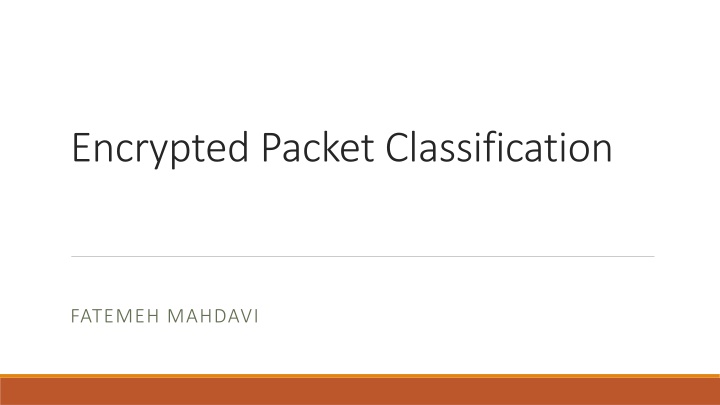
Encrypted Packet Classification Methodology using Deep Learning
Explore the methodology of encrypted packet classification by FATEMEH MAHDAVI, utilizing techniques like Stacked Auto-Encoder (SAE) and 1D CNN. The study includes dataset analysis, pre-processing steps, experimental results, and challenges faced in the process.
Download Presentation

Please find below an Image/Link to download the presentation.
The content on the website is provided AS IS for your information and personal use only. It may not be sold, licensed, or shared on other websites without obtaining consent from the author. If you encounter any issues during the download, it is possible that the publisher has removed the file from their server.
You are allowed to download the files provided on this website for personal or commercial use, subject to the condition that they are used lawfully. All files are the property of their respective owners.
The content on the website is provided AS IS for your information and personal use only. It may not be sold, licensed, or shared on other websites without obtaining consent from the author.
E N D
Presentation Transcript
Encrypted Packet Classification FATEMEH MAHDAVI
Content Introduction Related Works Methodology Experimental Results Challenges References
Methodology Dataset (VPN-nonVPN dataset (ISCXVPN2016)) Pre-processing Architectures Stacked Auto-Encoder (SAE) Deep Packet 1D CNN
1D CNN two consecutive convolutional layers, followed by a pooling layer. two-dimensional tensor is squashed into a one-dimensional. Vector fed into a three-layered network of fully connected neurons which also employ dropout technique Finally, a softmax classier is applied for the classification task.
Challenges Preparation .pcap format files. Time-consuming and complex training state because of large dataset.
References [1] M. Lotfollahi, M. Jafari Siavoshani, R. Shirali Hossein Zade, M. Saberian, "Deep Packet: A Novel Approach For Encrypted Traffic Classification Using Deep Learning," arXiv:1709.02656v3 [cs.LG], 4 Jul 2018. [2] G. D. Gil, A. H. Lashkari, M. Mamun, A. A. Ghorbani, "Characterization of encrypted and vpn traffic using time-related features," in 2nd International Conference on Information Systems Security and Privacy (ICISSP 2016), 2016. [3] B. Yamansavascilar, M. A. Guvensan, A. G. Yavuz, M. E. Karsligil, "Application identification via network traffic classification," in Computing, Networking and Communications (ICNC), 2017 International Conference on IEEE, 2017. [4] V. Paxson, S. Floyd, "Wide area traffic: The failure of poisson modeling," IEEE/ACM Transactions on Networking, vol. 3, no. 3, pp. 226-244, 1995. [5] D. Wang, L. Zhang, Z. Yuan, Y. Xue, Y. Dong, "Characterizing application behaviors for classifying p2p traffic," in International Conference on Computing, Networking and Communications, ICNC, IEEE, 2014. [6] J. Sherry, C. Lan, R. A. Popa, S. Ratnasamy, "Blindbox: Deep packet inspection over encrypted traffic," in Proceedings of the 2015 ACM Conference on Special Interest Group on Data Communication, SIGCOMM, ACM, New York, NY, USA, 2015. [7] Z. Wang, "The applications of deep learning on traffic identification," BlackHat USA, 2015.
